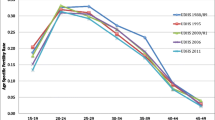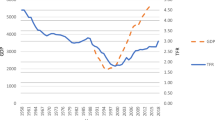Abstract
After experiencing rapid decline since the 1980s, fertility in Egypt seemed to be stalling during the second half of the 1990s. In an effort to identify the population segment(s) responsible for the stalling, this study considers fertility trends of women from three standard of living strata (low, middle, and high). Using data collected by the 1988, 1992, 1995, and the 2000 Egypt Demographic and Health Surveys, the study indicates that the reproductive behavior of women from high and middle standards households is largely responsible for stalling of the fertility decline during recent years, and that prospects for a lower fertility in the future is limited, once the gap between the three groups closes. This means that the expectation of achieving replacement fertility Egypt within the next 15 to 20 years is in doubt if the current trends in the both actual and desired fertility of the middle and high strata continued. The key for future decline in fertility is the decline in desired number of children below the current level of 3 children by at least one segment of the population. The fact none of the three population segments expressed a desired fertility below 3 children deprived the society of a vanguard group that leads the rest of the society to replacement level fertility.
Similar content being viewed by others
REFERENCES
Ali, K. A. (2002). Planning the Family in Egypt: New Bodies, New Selves. Austin: University of Texas Press.
Amin, G. A. (1995). Egypt's Economic Predicament: A Study in the Interaction of External pressure, Political Folly and social tensions in Egypt 1960– 1990. Leidon, The Netherlands: E.J Brill.
Becker, G. S. (1991). A Treatise on the Family. Cambridge: Harvard University Press.
El-Zanaty, F., & Way, A. (2001). Egypt Demographic and Health Survey 2000. Calverton, Maryland (USA): Ministry of Health and Population (Egypt), National Population Council and ORC Macro.
Fargues, P. (1997). State policies and the birth rate in Egypt: From socialism to liberalism. Population and Development Review 23(1), 115–138.
Filmer, D., & Pritchett, L. (1999). The effect of household wealth on educational attainment: Evidence from 35 countries. Population and Development Review, 25(1), 85–120.
Hallouda, A. et al. (1983). The Egyptian Fertility Survey, 1980.voorburg, Netherlands: International Statistical Institute. Vol. II.
Hassan, E., & Fathalla, M. (1995). Broadening contraceptive choice: Lessons from Egypt. In C.M. Obermeyer (Ed.), Family, Gender and Population in the Middle East: Policies in Context. Cairo: The American University in Cairo Press.
Hoodfar, H. (1999). Between Marriage and the Market: Intimate Politics and Survival in Cairo. Cairo: The American University in Cairo Press.
Ibrahim, S. (1995). State, women, and civil society: An evaluation of Egypt's population policy. In C.M. Obermeyer (Ed.), Family, Gender and Population in the Middle East: Policies in Context. Cairo: The American University in Cairo Press.
Kim, J., & Charles, M. (1978). Factor Analysis: Statistical Methods and Practical Issues. Sage University Papers. No. 14. Beverly Hills: Sage Publications Inc.
Palabrica-Costello, M., & Casterline, J. (2002). Fertility decline in the Phillipnes: Current status, future prospects. Paper presented to Exert Group Meeting on Completing the Fertility Transition. New York: United Nations.ESA/WP.172/Rev.1*. June. PP.529–538.
Pritchett, L. (1994). Desired fertility and the impact of population policies. Population and Development Review. 20(1), 1–55.
Robinson, W., & El-Zanaty, F. (1995). The Impact of Policy and Program in Egypt: The Egyptian Family Planning Success Story. Cairo, Egypt: National Population Council.
Stycos, J. M., et al. (1988). Community Development and Family Planning: An Egyptian experiment. Boulder: Westview Press.
United Nations Population Division (2002). Fertility levels and trends in countries with intermediate levels of fertility. Exert Group Meeting on Completing the Fertility Transition. New York: UN/POP/2002/BP/6. March 11– 14. www.un.org/population/publications/completingfertility/ffpspopdivpaper.pdf. Accessed April 10, 2002.




